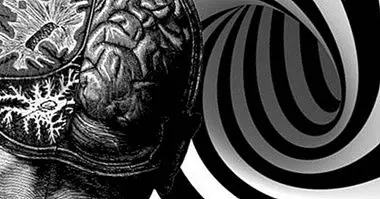Stuttering (dyspnea): symptoms, types, causes and treatment
Communication is an essential aspect in the human being. It allows us to connect with our peers, share experiences and ideas.
Among the different mechanisms available to us, oral language is one of the most used, and its learning one of the aspects that we devote more time to during our development. Since it is a skill that has to be trained progressively, it is usual that as we master it, difficulties arise.
But in some cases these difficulties may be indicating the presence of a communication disorder of greater or lesser severity. One of these disorders is stuttering, or dyspnea .
- Related article: "The 8 types of speech disorders"
Stuttering or dyspnea: a disorder of fluency
Stuttering or dyspnea is a communication disorder based on alterations in language fluency . It is a disorder that usually originates in childhood, and in which there are no problems in the capacity of speech or in the competence of the subject with it but in its implementation. This problem is not due to diseases, neurological problems or sensory or intellectual deficits.
The most visible symptom is the existence of repetitions of words or parts of words during the speech, as well as blockages and prolongation of sounds. Speech becomes little fluid and interrupted. In some cases circumlocutions are used in a way that alters the structure of the sentences to prevent the perception of the problem in fluency.
It is a problem linked to social speech, since stuttering only appears in the presence of a speaker , not existing in subvocal speech or when the subject is alone. In this way, it can be observed that there is an affective component related to the dyspnea.
The child or even adult live all these difficulties with a high level of anxiety , due to the capture of the difficulties as something inadequate and shameful. Feelings of abnormality or inferiority may arise. In fact, in some cases it can cause a high level of social withdrawal and even the refusal to speak.
Also, this anxiety tends to provoke a higher level of repetitions and interruptions in speech, so that a vicious circle can be established between anxiety and communicative problems. It is therefore a disorder that can cause serious affectation in the subject and its communicational and social development .
Dysphemia is a communication disorder that is chronic in some cases, although in a large number of cases it can remit completely or partially if it is treated correctly and its chronification is not caused.
Types of stuttering
Stuttering or dyspnea is a problem that can occur in different ways, depending on the type of fluidity alteration that occurs. Specifically, Three types of stuttering are usually identified .
1. Tonic dysfunction
It is a subtype of stuttering in which the problem is the existence of a blockage at the beginning of the speech , suffering a spasm when initiating the conversation that after an intense effort allows the expression.
2. Clonic dysfunction
This subtype of stuttering is characterized by the presence of slight muscle contractions that cause the repetition of sounds or whole syllables during the speech.
3. Mixed dysplasia
It is a combination of the previous two, appearing initial difficulties at the time of beginning the speech and repetitions derived from involuntary muscle contractions.
Origin of this disorder
The causes of stuttering or disorder of fluency have been explored and often discussed, being today the majority opinion that the etiology of this disorder of communication is found in both biological and environmental factors . It has been observed that there are psychological factors of great relevance for its appearance and maintenance, but the presence of alterations in brain functioning have also been speculated and analyzed.
With regard to biological and constitutional aspects, stuttering has been linked to the result of the activity competition between the cerebral hemispheres during development. Many people with stuttering present a dominance of the right hemisphere with regard to language, in addition to that it has been proven that they present a slight lapse between the time it takes to decide to speak and the motor response that allows it. Also exist anomalies in the arcuate fascicle , a brain region linked to language.
On the other hand, at a more psychological and environmental level, we can observe the presence of a conditioning in these children and adults, due to the repercussions in the form of ridicule or recriminations before their difficulties. This causes the presence of a high level of anxiety and frustration if it is not capable of correcting it, which in turn will generate less fluidity and an accentuation of difficulties. Although it is not considered the cause of the problem, it can maintain and chronify the problem.
- Maybe you're interested: "The 7 types of anxiety (causes and symptoms)"
Aspects to take into account when dealing with a case
Speech fluency can be trained in a manner that greatly reduces the presence of stuttering. Speech therapy can be very helpful, especially if applied with programs in which the need to accelerate the speech is reduced (Due to the anticipation of problems, many subjects tend to accelerate their speech, which usually causes them to make mistakes) and the level of tension and anxiety.
It's important to put attention on the presence of ridicule and criticism can be harmful , since they promote an increase in the tension of the subject and a more than likely worsening of their communication. The same happens if you try to urge them to speak or complete the sentences for them (an error that many members of the environment often commit).
In fact and as mentioned above, self-esteem can descend and cause the subject to become withdrawn and inhibited, avoiding social participation and affective bonding with other people. This contributes to make the disorder worse and become chronic. Family and social support, and the perception of it by the subject, is very important.
- Related article: "Types of psychological therapies"
Bibliographic references:
- American Psychiatric Association. (2013). Diagnostic and Statistical Manual of Mental Disorders. Fifth edition. DSM-V. Masson, Barcelona.
- Belloch, Sandín and Ramos (2008). Manual of Psychopathology. Madrid. McGraw-Hill. (Vol 1 and 2) Revised edition.
- Santos, J.L. (2012). Psychopathology. CEDE Preparation Manual PIR, 01. CEDE. Madrid.



















